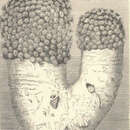Biology
provided by Arkive
Flowerpot corals, despite their delicate names, are generally aggressive animals (3). They are capable of developing elongated 'sweeper' polyps, like the sweeper tentacles of other corals, which can inflict severe tissue damage on a coral within their reach. It is therefore unusual to see other coral species growing close to the flowerpot coral (3), and it is believed that this adaptation benefits the flowerpot coral in the intense competition for space on the reef (5).
Like other reef-building corals, flowerpot coral polyps have microscopic algae (zooxanthellae) living within their tissues. Through photosynthesis, these symbiotic algae produce energy-rich molecules that the coral polyps can use as nutrition. In addition, the large polyps can use their tentacles to capture plankton to feed on, and thus are not as reliant on sunlight, required for photosynthesis, as some other coral species (4).
Flowerpot corals have separate male and female colonies (not all corals do) which release sperm and eggs into the water for external fertilisation. The fertilised egg develops into a free-swimming larva that will eventually settle on the substrate and develop into new colonies (3).
Conservation
provided by Arkive
Flowerpot corals are listed on Appendix II of the Convention on International Trade in Endangered Species (CITES), which means that trade in this species should be carefully regulated (1). Indonesia and Fiji have export quotas for flowerpot corals (1). In Indonesia it is one of five genera with the highest quotas, despite there being no scientific reason to suppose they are capable of supporting higher harvest levels than other genera (7). Flowerpot corals will form part of the marine community in many marine protected areas (MPAs), which offer coral reefs a degree of protection, and there are many calls from non-governmental organisations for larger MPAs to ensure the persistence of these unique and fascinating ecosystems (6).
Description
provided by Arkive
The appearance of this pretty coral belies its aggressive behaviour. Many individual coral polyps, (anemone-like animals that secrete a skeleton), form colonies which join together at the base of their skeletons. These colonies grow to form branches, columns, solid colonies that are dome-shaped, or colonies that adhere close to the substrate (2). Colonies may be meters across and sometimes whole sections of a reef face are covered exclusively by one branching Goniopora species (3). One Goniopora species, daisy coral, is named for its extremely large, flower-like polyps, and can grow to cover areas of six to ten meters (4). Each polyp has 24 long and fleshy tentacles that are normally extended day and night (2), although these quickly retract when touched revealing the massive skeletons beneath (4). Each Goniopora species differs in the shape and colour of their polyps, which allows their identification underwater (2).
Habitat
provided by Arkive
Flowerpot corals are most commonly found in turbid water protected from strong wave action (3)
Range
provided by Arkive
Occurs in the Indian and Pacific Oceans; from the coast of Mozambique, to the Red Sea, and east to northern Australia, southern Japan and Hawaii (2).
Status
provided by Arkive
Listed on Appendix II of CITES (1).
Threats
provided by Arkive
Flowerpot corals face the many threats that are impacting coral reefs globally. It is estimated that 20 percent of the world's coral reefs have already been effectively destroyed and show no immediate prospects of recovery, and 24 percent of the world's reefs are under imminent risk of collapse due to human pressures. These human impacts include poor land management practices that are releasing more sediment, nutrients and pollutants into the oceans and stressing the fragile reef ecosystem. Over fishing has 'knock-on' effects that results in the increase of macro-algae that can out-compete and smother corals, and fishing using destructive methods physically devastates the reef. A further potential threat is the increase of coral bleaching events, as a result of global climate change (6).
More specifically, Goniopora is potentially threatened by the live coral trade. Goniopora is one of the genera that dominates the live coral trade for use in aquariums. Goniopora and Euphyllia species are traded more than any other genus, partly because they normally do not survive more than a year, and therefore have to be replaced fairly frequently. A small amount of flowerpot corals are also traded as ornamental carvings, and for biomedical purposes; due to the similarity in structure of coral skeletons to human bones, they can be used in bone grafts (7).

